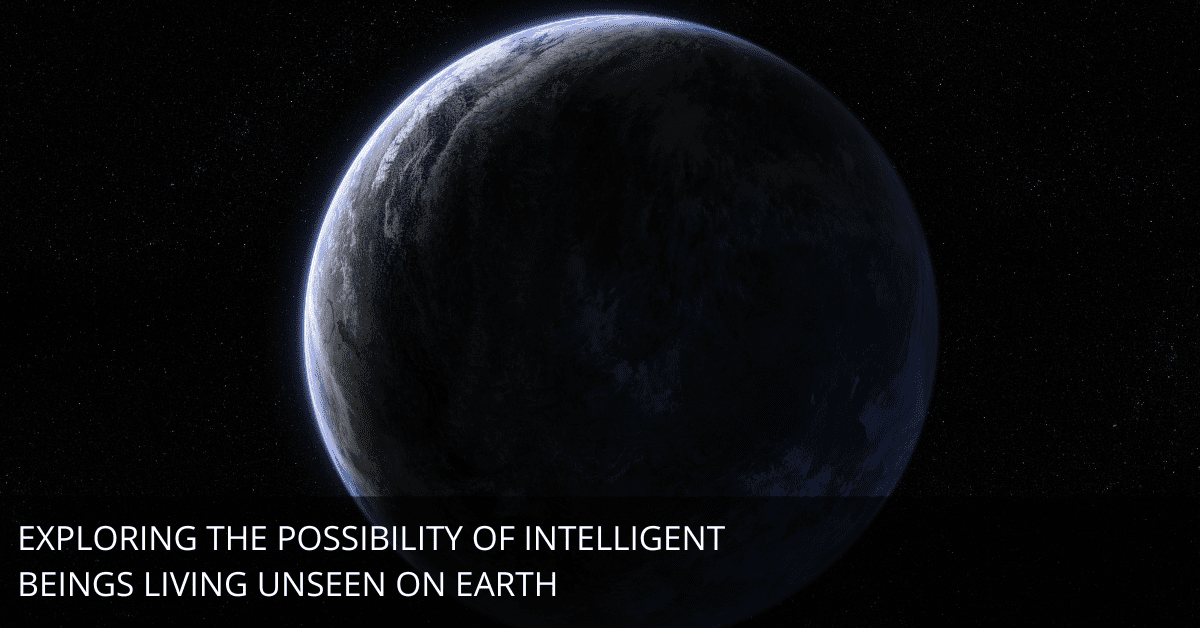
Imagine this: Earth is home to more than just humans and known wildlife.
What if intelligent, non-human entities have shared our planet all along, lurking in the depths of our oceans, concealed by advanced technology, or hidden beyond the limits of our perception?
This is the tantalizing premise of the Ultraterrestrial Hypothesis—an idea that challenges our understanding of what’s possible. Let’s explore this theory and see how it intersects with science, myth, and even your day-to-day reality.
Why Haven’t We Seen Them?
Humans are notoriously bad at noticing what we’re not looking for. Most of our technology is designed to detect threats or analyze data relevant to us. Ultraterrestrials, if they exist, may stay hidden because they’re incredibly good at it.
Take the deep ocean, for instance. Despite covering 70% of Earth’s surface, more than 95% of our oceans remain unexplored. That’s a staggering amount of real estate where intelligent beings could thrive completely undetected. The same goes for dense forests, underground caverns, or even dimensions beyond our sensory perception.
Think of the giant squid: sailors spoke of "Kraken" for centuries, yet it wasn’t until 2004 that scientists captured video proof of these creatures. If something that big could avoid detection for so long, what else might we be missing?
The Ancient Origins Theory
What if ultraterrestrials aren’t visitors at all but Earth’s original inhabitants? Some interpretations suggest they could be highly evolved, ancient species that predate humanity. Imagine a civilization that rose millions of years before humans, advanced to a technological zenith, and then chose—or was forced—to withdraw from the surface.
This idea aligns with cultural myths and legends. In many traditions, ancient beings live in hidden realms: the Nagas of Hindu mythology inhabit subterranean cities, and the Tuatha Dé Danann of Irish folklore are said to retreat to the "Otherworld." Could these tales be faint echoes of real encounters with ultraterrestrial species?
To wrap your head around this, think about how humans would seem to a species rediscovered long after we’ve vanished. Our satellites, abandoned skyscrapers, and underwater cities could look like mysterious artifacts from an unknowable past.
Cryptids as Ultraterrestrials?
Cryptids—animals rumored to exist but lacking scientific proof—might offer a bridge to understanding ultraterrestrials. Some cryptids, like the platypus or gorilla, were initially dismissed as hoaxes before being recognized as real species. What’s stopping the same from being true for legends like Bigfoot or the Loch Ness Monster?
Here’s how to start exploring this idea in your own backyard:
- Document your local legends: What cryptids or strange sightings are tied to your region? Many of these stories, passed down through generations, could hold kernels of truth.
- Join a field expedition: Cryptozoology groups often organize investigations into remote areas. If you’ve got the curiosity (and maybe a flashlight), this could be your chance to see something firsthand.
Even if ultraterrestrials don’t turn out to be Bigfoot, the act of investigating what lies beyond our current understanding might open the door to bigger discoveries.
Where Are They Hiding?
If these entities exist, their habitats might be hiding in plain sight. Here are some plausible places they could dwell:
1. The Deep Ocean
The oceans are Earth's final frontier. With depths reaching over 36,000 feet, they are inhospitable to humans but ideal for a species with advanced technology to evade detection. Submersibles like James Cameron’s Deepsea Challenger barely scratch the surface of what lies below.
2. Underground Caverns
Vast networks of underground caves, like Vietnam’s Hang Sơn Đoòng, are almost entirely unexplored. These could house ecosystems—and potentially civilizations—unknown to modern science.
3. Advanced Technology Concealment
What if ultraterrestrials manipulate light or sound to remain undetectable? Similar to how stealth aircraft avoid radar, advanced beings could easily "cloak" themselves, making them invisible to both human senses and machines.
Want to explore further? Start by reading reports from deep-sea exploration or cave-diving expeditions. These ventures often stumble upon new species, hinting at life forms thriving where we least expect them.
The Intersection of Myth and Science
Many cultures worldwide have stories about mysterious beings inhabiting hidden realms or emerging under specific conditions. From the Djinn in Islamic tradition to the skinwalkers of Navajo lore, these tales are surprisingly consistent in describing intelligent, elusive beings.
For example, myths often describe these entities as highly advanced, interacting with humans only sporadically. Sound familiar? It mirrors modern accounts of UFO encounters and abductions, suggesting a possible connection between ancient myths and contemporary phenomena.
Here’s a thought: the next time you read mythology, treat it like a historical record. Look for patterns. Why do so many cultures describe sky beings, hidden worlds, or sudden disappearances? Could these legends stem from real, albeit misunderstood, encounters?
What Does This Mean for You?
The Ultraterrestrial Hypothesis isn’t just an intellectual exercise—it’s a call to action. If beings more advanced than us have been here all along, we must rethink how we explore the world and understand our place in it.
Here are three ways to dive deeper:
- Read the Research: Start with works by Jacques Vallée, such as Passport to Magonia. Vallée’s approach blends science with folklore, making it an ideal entry point.
- Expand Your Curiosity: Pick a field trip—whether it’s to a deep-sea exhibit, a historical myth conference, or even a UFO sighting hotspot. Engage with the mystery firsthand.
- Challenge Assumptions: Keep an open mind about what’s possible. Write down three things you “know” to be true about life on Earth, then imagine a scenario where each is wrong. How does that change your perspective?
The takeaway here isn’t about "believing" in ultraterrestrials. It’s about embracing curiosity and the possibility that the world is far stranger—and richer—than we can imagine.
Closing Thought: What If?
What if the most extraordinary secrets of our planet aren’t in galaxies far away but right under our noses? Whether ultraterrestrials turn out to be ancient Earthlings, interdimensional wanderers, or simply an idea that pushes us to explore, they’re worth considering. After all, the search for the unknown is how we’ve made every leap forward—from discovering new continents to unlocking the secrets of DNA.
So, why not entertain the thought? Maybe the next "giant squid moment" is waiting to reveal itself. And maybe, just maybe, it’s an ultraterrestrial.

